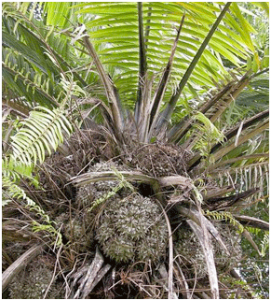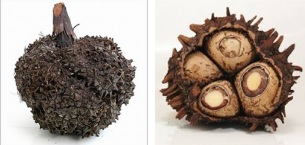
Tagua, also known as vegetable ivory, is native to tropical America, from Panama to South America.
It grows wild in the forests. The Tagua, Corozo or Vegetable Ivory, is the complex cellulosic seed kernel of “Phytelephas” white, like ivory, hard, heavy, smooth and opaque acquiring gloss when is polish, odorless, tasteless; but not elastic nor incorruptible like real ivory.
The plant takes 14 to 15 years since planting to collect the first fruits and production in all years and even centuries is not interrupted. Offering 3 crops a year approximately, it is estimated that a specimen of two meters high has less than 35 to 40 years old. Well-developed palm trees annually produce 15 to 16 heads or fruit. Per fruit gather about 20 seeds or nuts.

Tagua seeds are edible for humans and are an important food source for many animals of the jungle. The seeds are harvested by hand in the wild. Tagua has been used by the Embera and Wounaan for making crafts, which embody different representations of animals and plants in nature. The carvings are handmade; they do not use any type of machinery for the manufacture of handcrafts. In fact, tagua has helped the preservation of elephants since it has been a replacement of ivory tusks.
